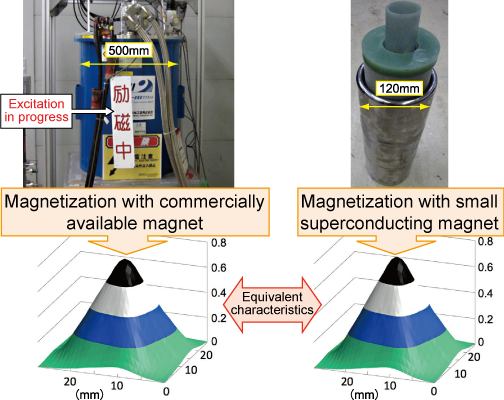7. Small super-conducting magnet
- A superconducting magnet was developed with high temperature superconducting material which can be utilized in material analysis equipment.
- Verification was obtained that the developed magnet had equivalent magnetising performance as other commercially available magnets.
Superconducting magnets used in materials analysis are commercially available, however, since they are made with metallic superconducting wire, they must be cooled to liquid helium temperature (-269℃)necessitating large ancillary equipment. Consequently, a superconducting magnet was developed comprising high temperature super conducting material Galdolinium obtained through a melting and solidification process as the bulk material in cylindrical form. This small versatile product can be applied to other areas involving magnetic fields, other than in materials analysis equipment. Superconducting bulk material has very high current density at liquid nitrogen temperature (-196℃). Magnetic field analysis was employed to investigate the optimum structure, which was determined as being superconducting bulk material in a ring shape with an external and internal diameter of 80 mm and 50 mm respectively. The latter was then reinforced through resin impregnation, and stacked to form the small superconducting magnet which was tested to evaluate performance. Confirmation was obtained that a 2.59 T magnetic field was produced at the core when the stack consisted of 10 layers (Fig 1).
To produce the same magnetic field using existing technology equipment with copper coil 1 m across, and a commercially available superconducting magnet with a 500 mm diameter, would be required. In order to assess the magnetization function to re-magnetize a magnet the newly developed small superconducting magnet and a commercially available superconducting magnet were tested in magnetization of a common 30 mm diameter trial material. The results showed that it was possible to obtain similar magnetic field distribution characteristics, and confirmed that both types of magnet offered high precision magnetisation (Fig 2).
 Fig. 1 small superconducting magnet
Fig. 1 small superconducting magnet
(10 layers of bulk material with outside diameter of 80 mm, and inside diameter of 50 mm) Fig. 2 Comparison of magnetization and magnetic field distribution in common test material
Fig. 2 Comparison of magnetization and magnetic field distribution in common test material
(diameter of 30 mm)